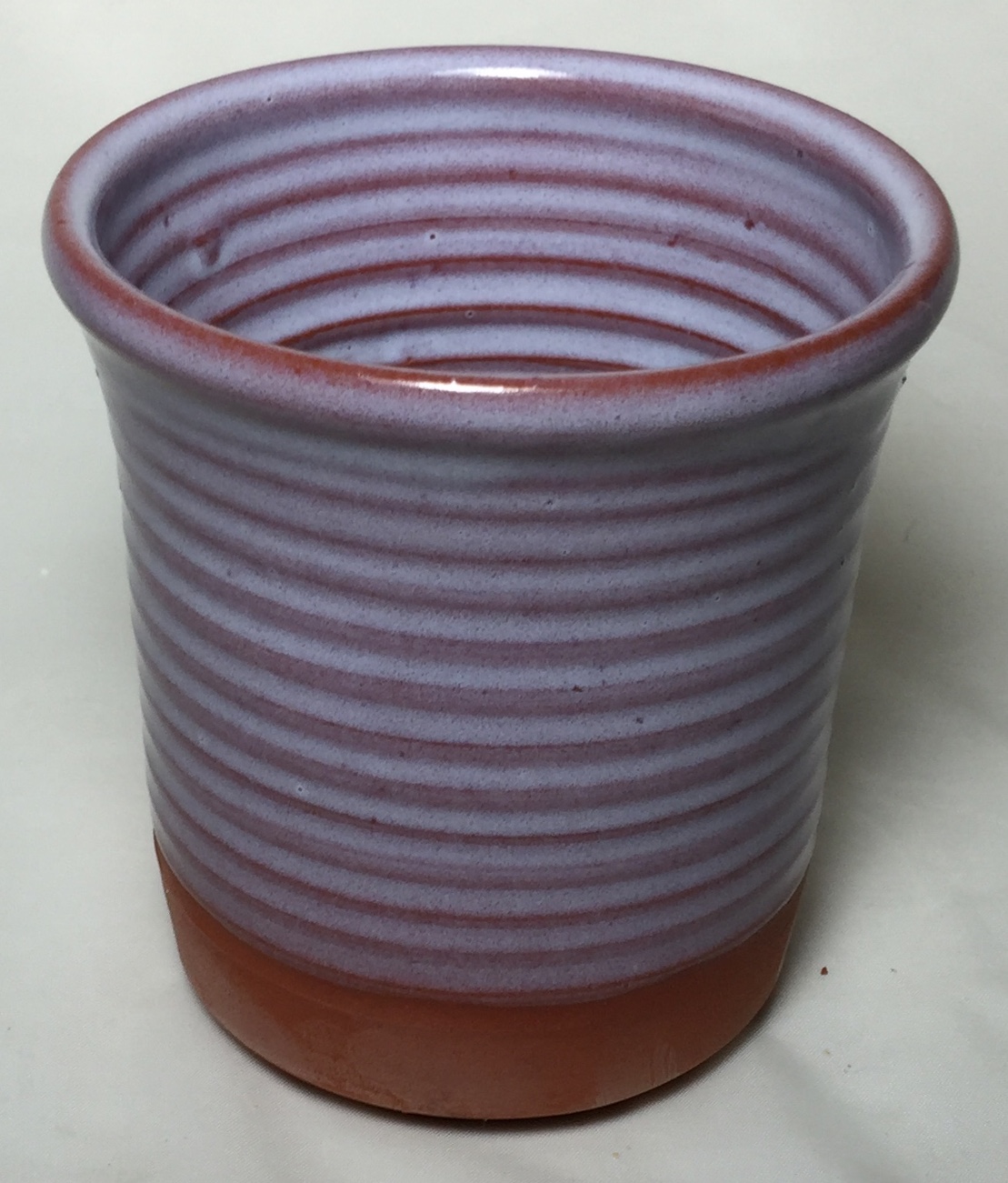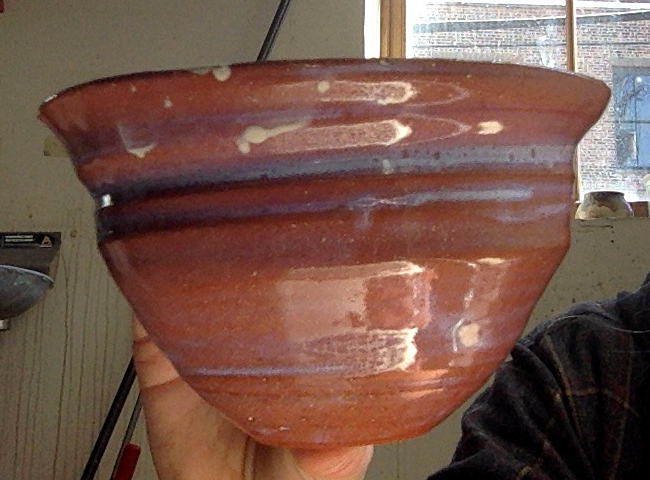Electric Mid&Hi Fired Ceramics
Potters & Sculptors - Making Rock from Mud
Naragon White Glaze- Accidental Recipe Modification
I'm going to just open this thread with a disclaimer. Drinking wine and glaze mixing at the same time do not make good bed fellows. Be that as it may, I mixed-up a test batch of Naragon White and failed to add the Zircopax & Bentonite. Because that was such a good decision, I then proceeded to glaze all of my bowls with a layer of Pseudo Naragon White, ALL OF THEM. Despite my repeated stupidity, the Kiln God was uncharacteristically merciful. When I took my bowls out of the kiln, sitting on top of the iron red was a subtle light blue. There was no crazing or bubbling and I really like the color. My question to you is food safety and why it was blue? You see, I've been eating off of them, and I'd prefer not to do anymore brain damage...
Naragon White Cone 6 Oxidation Glaze
Dolomite 4%
Gertsley Borate 26%
Whiting 6%
F-4 Feldspar 31%
EPK Kaolin 8%
Silica (Flint) 25%
Total 100%
Add:
Zircopax 12%
Bentonite 2%
Tags:
Replies to This Discussion
-
Permalink Reply by Norm Stuart on October 9, 2016 at 10:23am
-
Rosemary - Please post a photo of the blue glaze.
One possible explanation is that trace amounts of iron can create blue color in some chemistry. This more often happens in a glaze with a high silica-boron to alumina ratio - about 11 to 1 in this recipe. Zircon acts like alumina and so the zircopax addition would interfere with the creation of this blue color.
Nearly pure alumina with a a trace amount of iron is called a sapphire which requires much higher temperatures and pressures than we use in a kiln. Although the pressure and temperatures we use are lower than found deep in the Earth, in making glazes we're essentially making a layer of gemstones.
A alumina crystal with less than 0.1% iron impurities surrounded by carbon crystals
-
Permalink Reply by Rosemary Davis on October 9, 2016 at 11:07am
-
Thank you so much for your reply! I'll see if I can upload a picture.
-
Permalink Reply by Rosemary Davis on October 9, 2016 at 11:14am
-
Here's a picture of it. Hopefully you can see the blue. It's subtle.
- Attachments:
-
-
 IMG_0243.jpg, 1.6 MB
IMG_0243.jpg, 1.6 MB -
 IMG_0244.jpg, 2 MB
IMG_0244.jpg, 2 MB
-
-
Permalink Reply by Norm Stuart on October 9, 2016 at 6:22pm
-
I think the blue cast you're seeing is boron blue clouding from the boron in the Gerstley Borate and the calcium in the Whiting. In other words, Calcium Borate crystals which refect blue and add a level of opaqueness.
Digitalfire has this essay on the effect. They say cooling more quickly can eliminate it.
https://digitalfire.com/4sight/glossary/glossary_boron_blue.html
Boron Blue
Boron blue is the bluish haze or clouding in a transparent boron glaze that results from the crystallization of calcium borate in the glass matrix during cooling. This is a common problem in borate glazes, the higher the boron the worse. The more CaO and B2O3 available and the slower the kiln cools, the worse the effect will be. So first, try cooling faster (of course there is a risk for dunting with this approach).
But the most effective approach is to adjust the chemistry. Is the glaze melt fluid, does it melt really well to the point of flowing if it is thicker? Then reduce the boron (the less fluid melt will discourage crystal growth). It is best to have no more boron than is necessary to get a good melt. Is the CaO high (compared to other glazes of the same type)? Then try reducing that.
If the glaze is melting well it will likely tolerate the addition of more Al2O3. Increasing it without changing anything else may be all that is needed. There are added benefits to this also (e.g. better hardness, lower expansion). Why does this help? The Al2O3 stiffens the melt (as noted, the crystals grow in a fluid melt).
These changes are done using glaze chemistry. If you enter a recipe into your account at Insight-live.com it can show you the amount of each oxide (e.g. CaO, Al2O3, SiO2) and you can click materials to see what oxides they contribute. Then, by duplicating the recipe and viewing it side-by-side with the original you can adjust recipe ingredients and see the impact on the chemistry. It may be that changing some or all of the frit for a similar one, but of higher Al2O3 and lower B2O3, might move things in the right direction. But the most common way to add Al2O3 is to increase the kaolin and reduce the silica (because the kaolin contributes both Al2O3 and SiO2).
The most non-technical way to adjust the recipe is to simply blindly try other frits. While this might reduce the boron blue, the different chemistry they bring can affect many other properties (like color response, thermal expansion, melting temperature, hardness and durability, surface character, matteness or gloss). The problem is the balance in the chemistry and changing one or two oxides at a time is the key to effectively deal with the problem.
Boron blue can also be used as a decorative effect, especially on low temperature ware.Pictures

Boron blue in low fire transparent glazes
This high boron cone 04 glaze is generating calcium-borate crystals during cool down (called boron-blue). This is a common problem and a reason to control the boron levels in transparent glazes; use just enough to melt it well. If a more melt fluidity is needed, decrease the percentage of CaO. For opaque glazes, this effect can actually enable the use of less opacifier.

The perfect storm to create boron-blue clouding at low fire
Two clear glazes fired in the same slow-cool kiln on the same body with the same thickness. Why is one suffering boron blue (1916Q) and the other is not? Chemistry and material sourcing. Boron blue crystals will grow when there is plenty of boron (and other power fluxes), alumina is low, adequate silica is available and cooling is slow enough to give them time to grow. In the glaze on the left B2O3 is higher, crystal-fighting Al2O3 and MgO levels are alot lower, KNaO fluxing is alot higher, it has more SiO2 and the cooling is slow. In addition, it is sourcing B2O3 from a frit making the boron even more available for crystal formation (the glaze on the right is G2931F, it sources its boron from Ulexite).

What has this low fire transparent glaze turned blue?
It is made from 85% Ferro Frit 3134, 7.5% kaolin and 7.5% silica. While not obvious from the recipe, one look at the chemistry of this (as displayed when you enter a recipe into your account at insight-live.com) will show very low Al2O3. Frit 3134 has almost no Al2O3, yet it is an essential component of functional glazes (for durability, resistance to crystallization, stability during firing). The kaolin is the only contributor of Al2O3 and there is only a little. A simple fix would be to use Ferro Frit 3124 instead, remove the silica and increase the kaolin to 15.

What happens when glazes lack Al2O3?
This happens. They are glossy, but lack thickness and body. They are also prone to boron blue clouding (micro crystallization that occurs because low alumina melts crystallize much more readily on cooling). Another problem is lack of resistance to wear and to leaching (sufficient Al2O3 in the chemistry is essential to producing a strong and durable glass). This is a good example of the need to see a glaze not just as a recipe but as a chemical formula of oxides. The latter view enables us to compare it with other common recipes and the very low Al2O3 is immediately evident. Another problem: Low clay content (this has only 7.5% kaolin) creates a slurry that is difficult to use and quickly settles hard in the bucket.
-
Permalink Reply by Rosemary Davis on October 9, 2016 at 6:51pm
-
Thank you so much!
Videos
Use These Links to Support Us
Low cost flat lapping disc can be used on you potters wheel if you, drill bat pin holes in it, and provide a trickle of water to cool it. At amazon.com, 120 grit for aggressive material removal. Click the image to purchase
Members have had great things to say about John Britt's new book, Mid-Range Glazes. Click the image to buy from Amazon.com
Purchase Glazes Cone 6 by Michael Bailey, The Potters Book of Glaze Recipes by Emmanuel Cooper, or Making Marks by Robin Hopper, all available at amazon.com. Mastering Cone 6 Glazes by John Hesselberth & Ron Roy is now out of print.
Harbor Freight is a great place to find unbeatable prices for better HVLP spray guns with stainless steel parts and serviceable economy models, as well as detail guns, all tested by our members for spraying glazes, as well as compressors to power the guns. As yet no one has tested and commented on the remarkably inexpensive air brushes at harbor freight.
The critter siphon gun is a spray alternative that is well liked by some of our members, and is available at amazon.
Amazon is also a competitive source for photo light tents for shooting professional quality pictures of your work. They also have the EZ Cube brand favored by several of our members. You might also want to purchase the book Photographing Arts, Crafts and Collectibles . . .
If you are up to creating videos of your work or techniques you might want to invest in a flip video camera
Following are a few scales useful for potters. Ohaus Triple Pro Mechanical Triple Beam Balance, 2610g x 0.1g, with Tare $169.00
And finally a low cost clone of the OHaus. The Adam Equipment TBB2610T Triple Beam Mechanical Balance With Tare Beam $99.62
ebay is a great alternative for many tools and the equipment used in the ceramics studio - kilns, wheels, extruders, slab rollers are often listed there both new and used.
Tips for Members
If you just want to spout off, it is best accomplished as a blog posting. If you want to get more guidance and ideas from other members, ask a question as a new discussion topic. In the upper right corner of the lists for both types of posting, you will find an "+Add " button. Clicking it will open an editor where you create your posting. 4/16/2014
© 2026 Created by Andrea Wolf.
Powered by
![]()